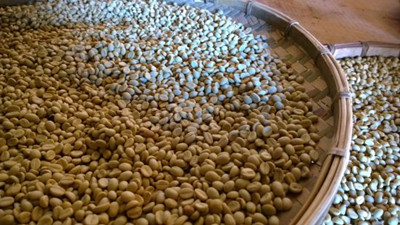How do you bake the coffee beans you just picked? Coffee bean roasting Xinde coffee bean baking method coffee
Freshly picked coffee
1. Raw bean processing:
1. Picking
It is divided into mechanical picking and manual picking. Mechanical picking is suitable for coffee plantations with flat land and large areas. Brazil is the most popular country in the world to use mechanical picking coffee. This method is characterized by low cost and high efficiency, but the coffee beans picked are uneven and of poor quality. For coffee beans with higher quality requirements, the method of manual picking is generally adopted, which ensures that the coffee fruit after picking is uniform in size, close in maturity and free of other impurities, and is also conducive to the later processing of coffee beans.
2. From fruit to coffee beans:
The processing methods from coffee fruit to coffee beans can be roughly classified as dry processing and wet processing.
Dry processing: coffee fruit is the use of sunlight and ventilation and other natural conditions to dry dehydration, and then put the dried coffee fruit into the shell to pulp, peel and silver skin. This method is the most economical and traditional processing method, and the coffee beans treated in this method can maintain the aroma for a long time, but at the same time will have a certain environmental smell. At present, many parts of Africa and Asian countries use this method, but with the advancement of science and technology, many places have begun to use dryers to dry coffee fruits.
Wet processing: also known as washing method processing, the use of soaking method to screen coffee fruit, and then the screening of the fruit through fermentation, extrusion and other methods to remove the peel, pulp and silver skin surface sticky pulp, processed coffee beans will retain the surface of the silver skin for storage, this state of coffee beans called "parchment coffee beans"(Parchment Coffee), has to wait until the export before using a peeling machine to remove the dried silver skin. The biggest advantage of wet processing is that the appearance of coffee beans is excellent, and the original taste is maintained well: the disadvantage is that the processing cost is higher and a lot of water is required. Generally used for the processing of high-quality coffee beans.

II. Baking
Coffee beans roasting is the use of specific equipment, through high temperature to convert starch into sugar and acidic substances in the process, in this process, cellulose and other substances will be carbonized to varying degrees, moisture and carbon dioxide will volatilize, and protein will be converted into enzymes, and fat residue combined together, forming an oil film layer on the coffee surface, coffee beans themselves will also be roasted and expanded, internal pores. After roasting coffee beans can produce a special aroma and different flavors, can be used for brewing coffee.
Coffee beans roasting is a complicated processing technology, with quite professional, want to make delicious coffee beans, need to have perfect equipment and high coffee roasting technology, so, unless it is to satisfy personal pleasure, generally not suitable for home.
Coffee beans vary in depth and taste depending on the heat and time of roasting. Different characteristics of coffee beans, different drinking methods determine the depth of roasting coffee beans. In general, light roast, coffee beans will be light brown color, strong acidity; dark roast, darker color, bitter increased. Coffee beans are traditionally roasted in eight different degrees:
Light roast-slightly yellowish brown, less intense aroma and flavor;
Cinnamon-Cinnamon color, slightly better aroma, a type of American coffee;
medium roast--maroon, mellow, moderately sour, a type of American coffee;
medium roast (High)-slightly stronger than light roast, acid with bitterness, aroma and flavor with good;
City--the word comes from New York City and is the standard roast for Colombia and New York-style coffee;
Full City--no sour taste and bitter taste, suitable for iced coffee;
Strong roast (French)-French, also known as European, due to the strong degree of roasting, coffee beans fat ooze surface, color black, bitter strong, with a unique flavor;
Strongest roast (Italian)-also known as Italian, roast degree is strong, coffee beans charred black, with burnt flavor, no aroma, suitable for brewing Italian steam coffee.
III. Storage:
1. Raw beans:
The raw coffee beans before frying are only for convenient transportation, no special packaging conditions are required, depending on the different production areas.
In consideration of economy and practicality, it is generally packed in 60 kg gunny bags and further processed after arriving at the destination. Of course, there will be some unusual packaging, such as Jamaica Blue Mountain is packed in 70 kg barrels.
2. Cooked beans:
Roasted coffee beans are easy to oxidize with oxygen in the air, causing the aroma contained in them to volatilize, oil degradation, and a rotten smell. How to maintain coffee aroma, put an end to the deterioration caused by external temperature, humidity and light, is the main task of coffee bean storage.
In addition, because coffee beans will produce a considerable amount of carbon dioxide gas after roasting, and carbon dioxide will also reduce the aroma of coffee, so the packaging of cooked coffee beans in addition to avoid contact with the air, but also try to eliminate the carbon dioxide emitted by coffee beans. Currently, there are several common coffee bean packaging methods:
Flexible non-airtight packaging: This is the most economical one. Usually adopted by small local roasters because they guarantee a quick supply and coffee beans can be consumed in time. Coffee beans in this way can only be stored for a short time. Usually no more than a week.
Airtight packaging: suitable for bars, shelves or families, mainly in small bags and cans, vacuumized and sealed after coffee is packed. Because carbon dioxide is produced after roasting, this method can only be carried out after the coffee is placed for a period of time to degas. It takes a few days to store, and the coffee beans should be placed longer than the coffee powder. Because it does not need to be isolated from air during storage, the cost is low. Coffee in this package should be used up within 10 weeks.
One-way valve packaging: can be used in a variety of sealed containers. Roasted coffee is put into a special airtight container with a one-way valve, which can only allow gas to be excluded without flowing in, ensuring the insulation of coffee from the outside air and the timely discharge of carbon dioxide generated. A separate storage phase is not required, but there is some loss of aroma due to outgassing. This method avoids the formation of putrefaction, but does not prevent the loss of aroma.
Pressurized packaging: This is the most expensive way, but it can preserve coffee for up to two years. The size depends on the type of user, home or bar. After a few minutes of roasting, the coffee can be vacuum-packed. After adding some inert gas, the package is maintained at a suitable pressure, and the coffee beans are stored under pressure, so that the aroma remains on the fat, thereby improving the flavor of the beverage.
Important Notice :
前街咖啡 FrontStreet Coffee has moved to new addredd:
FrontStreet Coffee Address: 315,Donghua East Road,GuangZhou
Tel:020 38364473
- Prev

Boutique Coffee beans introduce blending Coffee Flavor Coffee with Coffee beans
Blending coffee is the blending of two kinds of high-quality coffee will suppress each other's unique flavor, matching should also pay attention to color, matching coffee beans also have different characteristics to reconcile an attractive taste. Although some fixed varieties of coffee can be drunk directly as individual coffee, most of the coffee has more or less defects in flavor. For example, there is no special flavor
- Next

Introduction of fine coffee, introduction of coffee, coffee beans, coffee, coffee.
Blending coffee is the blending of two kinds of high-quality coffee will suppress each other's unique flavor, matching should also pay attention to color, matching coffee beans also have different characteristics to reconcile an attractive taste. Although some fixed varieties of coffee can be drunk directly as individual coffee, most of the coffee has more or less defects in flavor. For example, there is no special flavor
Related
- Guji coffee producing area of Guji, Ethiopia: Humbela, Shakiso, Wulaga
- What is the most expensive variety of Qiloso in BOP multi-variety group?
- How to store the coffee beans bought home?
- Why are Yemeni coffee beans so rare now?
- Ethiopian Sidamo all Red Fruit Sun Sun Santa Vini Coffee beans
- SOE is mostly sour? What does it mean? Is it a single bean? what's the difference between it and Italian blending?
- Is Italian coffee beans suitable for making hand-brewed coffee?
- How to choose coffee beans when making cold coffee? What kind of coffee beans are suitable for making cold coffee?
- Just entered the pit to make coffee, what kind of coffee beans should be chosen?
- Can only Japan buy real Blue Mountain Coffee? What are authentic Jamaican Blue Mountain coffee beans?

